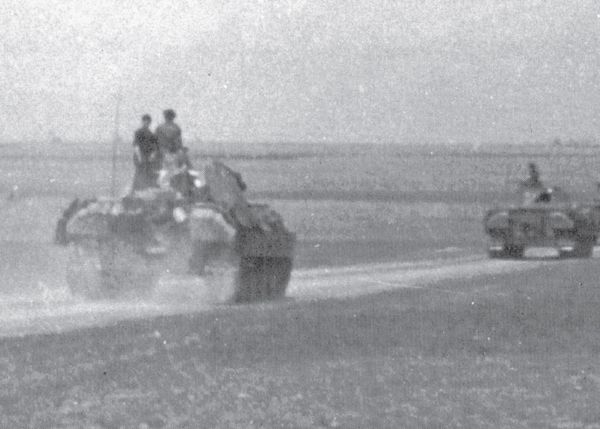Warszawa II (7 page)
Authors: Norbert Bacyk

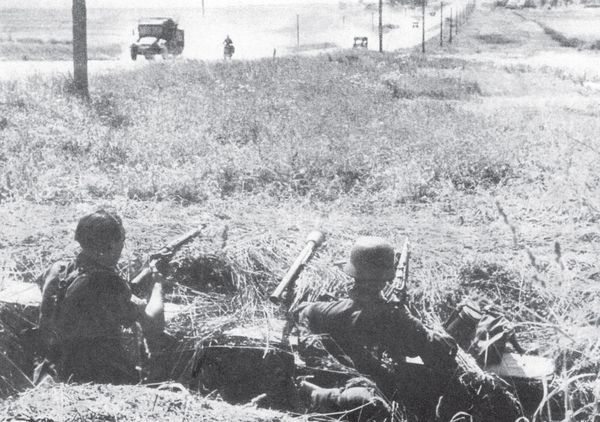
Forward at the frontline! German fixed positions at the furthermost point along the frontline. Retreating units race by the two entrenched soldiers in July 1944 outside Warsaw. Note the Panzerfaust!
(All pictures: Leandoer & Ekholm archive)
An assault-gun StuG 40 Sd Kfz 142/1 Ausf. G and an anti-tank 5 cm Pak 38 from a Waffen-SS unit lying in ambush on the eastern front, summer 1944. (CAW)
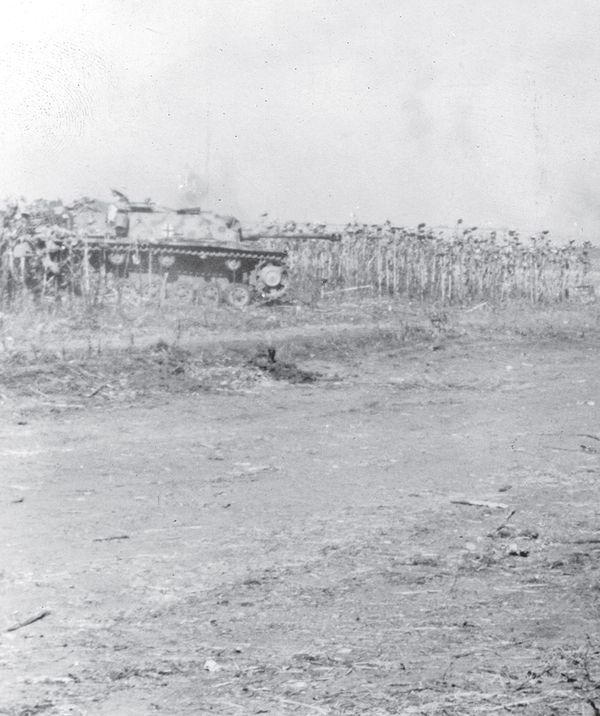
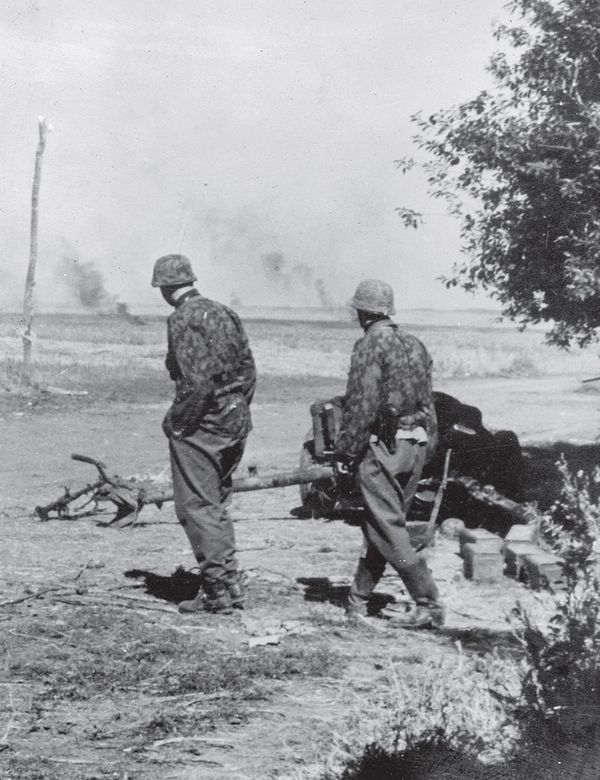
In this situation, the status of the 9th Army became critical. On July 27, Hitler appointed General Reiner Stahel as commander of the entire Warsaw military district. He was regarded as an expert in urban warfare. Actually, Stahel was an officer in the Luftwaffe, but had already been posted as commandant over Rome and Vilnius in 1944. Hitler ordered Stahel to defend the city “at any price.” The Germans knew about the plans for an uprising and therefore prepared their troops for fighting on two fronts. The troop strength at the city's outposts was reinforced and soldiers from Pionier-Bataillon 654 awaited orders to blow up the bridges. Model wanted to stop the 2nd Tank Army with a sudden counter-attack east of the Praga district, and at the same time, protect Warsaw with division “Herman Göring “ and the 73rd Infantry-Division. He also got the all-clear to redeploy 19th Tank-Division from the north to the Warsaw region and placed it on combat-ready status.
On the other side of the front, General Radzjijevskij's two tank corps approached Praga on July 28. The third, the 16th Tank Corps, remained a little in the background, but quickly tried to link up with the rest of the army by attacking directly along the WisÅa's eastern shore â behind them, trailed rifle divisions from the 8th Guards Army. General Vasilij Tjujkov received orders to cross the river south of the capital (the order was formally issued on July 29, 1944). At the same time, in the area around Kazimierz Dolny, the 69th Army had already begun to cross the river and the 1st Polish Volunteer Army stood outside DÄblin. At Siedlce, the rapid response force and the 47th Army, which had just arrived in the area, were engaged in heavy fighting. After taking Brest, the 70th Army relentlessly drove a fortification garrison westwards, while the 61st Army had just begun to withdraw from the 1st Belorussian Front.
The 2nd Tank Army's resources, July 27, 1944
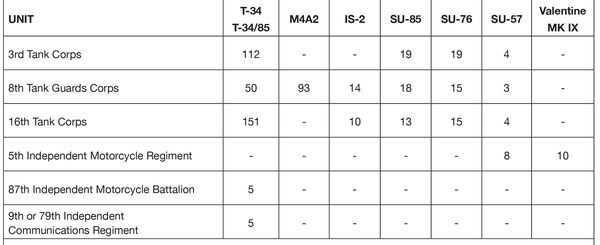
The table displayed above was compiled by General Radzjijevskij's staff on August 28, 1944 and may not be entirely accurate.
It is not clear if the report overlooks certain independent units who operated under the direction of the army commander. In addition, there is some question as to whether any of the tanks were otherwise occupied or undergoing repair. The list includes a total of 568 tanks and tracked assault guns (among them 19 SU-57s). According to other sources, which are also based on Soviet records (T. Sawicki, W. WoÅoszyn), the 2nd Tank Army on July 17, 1944 was composed of a total of 810 armoured vehicles; (665 tanks, 145 tracked assault-guns) while on July 27, 1944, reports indicated they still possessed some 680 armoured vehicles.
A Polish “Studebaker” US-6 with soldiers from the 1 st Army in liberated Lublin, July 1944. (WAF)


A Polish “Willy's” jeep (see right) and a “Studebaker” US-6 from the 1st Army in liberated Lublin, July 1944. On the left, a column of Soviet lorries of model GAZ-AA passes by. (WAF)
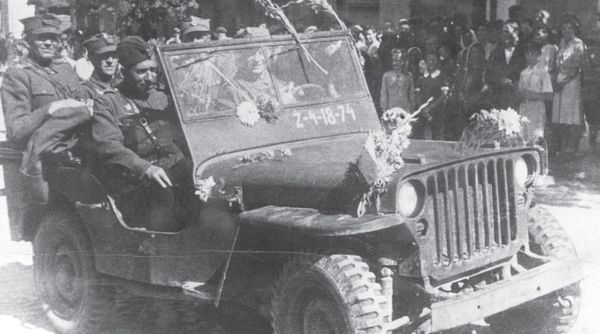
A Polish “Willy's” jeep from the 1st Army in liberated Lublin, July 1944 (WAF)

An assault-gun of model StuG 40 Sd Kfz 142/1 Ausf. G on the eastern front, summer 1944. Note that the muzzle on the StuG 40 has no muzzle-suppressor. (CAW)
July 29 â August 6, 1944
O
n the morning of July 29, tanks from the 3rd Tank Corps under the command of General Nikolaj Vjedjenjejev resumed their northward offensive. From the east, they had gone around elements of the 73rd Infantry-Division, which were retreating towards Warsaw, and cut off the main roadway towards Siedlce between MiÅsk Mazowiecki and KaÅuszyn. This accomplished, the corps' tank brigades once again headed west and reached the StanisÅawów-region. General Vjedjenjejev then sent out reconnaissance patrols in the direction of TÅuszcz. That evening, the 3rd Tank Corps' advance troops cut off the railway line between Warsaw and BiaÅystok.
East of the 3rd Tank Corps along the WisÅa, units from General Ivan Dubovoj's 16th Tank Corps went on the offensive. These were probably the same tank troops from the corps who had, on or about this time, destroyed the German armoured train nr. 74 along the stretch between Otwock and Pogorzel Warsaw (It may also have been tanks from the 109th Tank Brigade). But following immediately behind the 3rd Tank Corps, General Aleksiej Popov's 8th Tank Guards Corps also rolled northwards and, at the same time, secured the tank army's right flank. On July 29, this corps reached MiÅsk Mazowiecki.
The Germans tried to assemble their combat forces as quickly as possible for Generalfeldmarschall Model's counter-attack. That day, responsibility for the defence of Praga was placed on Lt. General Dietrich von Saucken's XXXIX Panzer-Corps, which had been deployed there from the 4th Army, which at that time was being reconstructed in Lithuania. Under Von Saucken's command were the 19th Panzer-Division and the Parachute-Panzer-Division “Herman Göring.” His greatest problem was the all too real shortage of combat forces. General Hans Källner's 19th Panzer-Division had just begun to move in the direction of Warsaw, starting out from the northeast near Wysków. Moreover, this force didn't mount to a full formation since the transport of the Panzergrenadier-Regiment
73 and the division's artillery from Holland had not yet been completed. By July 29, only one of these Kamfgruppe had actually arrived in the area around Praga, almost certainly strengthened by a couple of tanks from Panzergrenadier-Battalion “Panther.” The rest of the formation was expected to arrive over the coming days.
The situation for division “Herman Göring” was far from ideal. They were forced to transport General Schmalz's force in, all told, 72 railway coaches As a result of Soviet bombing raids on the capital city's railway stations, large sections of the division, tanks included, were off-loaded outside the city in Pruszków and Piastów â after which, these units were reassembled in Warsaw's western suburbs, from where they then made their way to Praga. The outcome of this, given the limited capacity of the suburbs' railway stations; was that off-loading became an excessively drawn-out process. The first units from Division “Herman Gorimg” to turn up in Warsaw arrived on July 25, and on the following day they began to demonstratively drive through the city. An intention of this, of course, was to make a psychological impression on the city's citizens. To a certain extent, this also appears to have been the case.

Commander of the 5th SS-Panzer-Division “Wiking” until Aug. 11, when he was appointed commader of the newly formed IV SS-Panzer-Korps, SS-Gruppenführer Herbert Otto Gille. To the right of him is SS-Obersturmbannführer, Hans Dorr, commander of SS-Panzergrenadier-Regiment 9. “Germania”. The photo was taken in July 1944. (Leandoer & Ekholm Archive)
A group of HQ officers of the 4th Panzer-Division with the commander of the Division at the fore, General von Saucken. The vehicle on the right is a Sd Kfz 250/1 Alte. The man dressed in black is probably the commander of Panzer-Regiment 35, the division's panzer regiment. The picture is taken in July 1944. (Leandoer & Ekholm Archive)
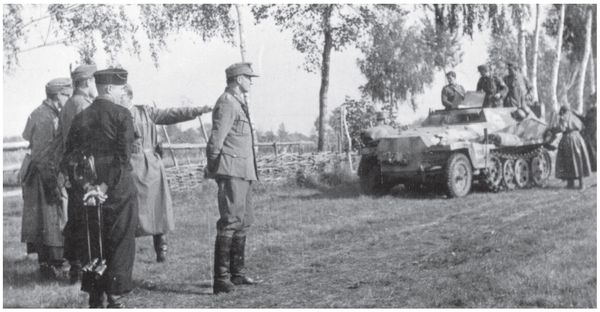
On July 30, the units of the Fallschirm-Flak-Regiment “Herman Göring”, arrived in Praga, along with elements of the Fallschirm-Panzer-Artillerie-Regiment “Herman Göring”, Pionier-Bataillon and Panzer-Aufklärungs-Abteilung. The march through Warsaw of the most vital force, that is to say â the Fallschirm-Panzer-Regiment “Herman Göring” and two parachute panzer-grenadier regiments, (Fallschirm-Panzergrenadier-Regiment 1&2), was, on the other hand, decidedly disoriented. The panzer regiment had arrived in a weakened state because as late as July 3, on special orders from Hitler, a portion of I Battalion's personnel had been sent to Holland to equip the forces sent there with the new “Panther” tanks. The result of this was that the first vehicles to roll into battle were the Tiger tanks of the III Battalion, whose 10th Company received support from infantry troops out of the 73rd Infantry-Division, which was retreating from the area around Siennica. The following day, the company covered the infantry's withdrawal south of Sulejówek, and a portion of the III Battalion became involved in fighting near Pogorzela. At the same time, the Fallschirm-Panzergrenadier-Regiment I, supported by artillery, consolidated with units from the II Panzer-Abteilung outside of Marki prior to the planned counter-attack, while Fallschirm-Panzergrenadier-Regiment 2 was still in route to the front.
General von Vormann was still counting on support from the 6th Luftflotte and two grenadier brigades. The Luftwaffe had at its disposal a vast number of anti-aircraft batteries from the 80th Regiment in the Warsaw region â everything ranging from units armed with light 20mm calibre weapons, to heavy 88mm artillery guns. All told, this mounted to 19 heavy batteries, 3 medium-heavy batteries and 11 light batteries. In addition to these resources, based at nearby airfields were Ju 87D bombers from 1 Gruppe in 1 Staffel out of the SG 1 (Schlachtgeschwader 1) and the 4th Flieger-Division in the 77th StG (Sturzkampfgeschwader), along with Bf 109G fighter planes from the 1 Gruppe from JG 51 (Jagdgeschwader 51). These were not especially impressive combat planes, but â thanks to the extensive distance separating Soviet airfields from the field of battle â the German planes had a local advantage in the air over the battle area outside Warsaw. Now and then, the 6th Luftflotte also took advantage of its greater strength in air battles, but they continued to concentrate most of their air power and superiority on supporting the 2nd Army. This, for the Germans, favourable balance of air power over the Warsaw area was not to change radically until the second week of August.
A Bren gun armoured vehicle filled with Soviet soldiers pursuing retreating German forces, in eastern Poland, July 1944. (Leandoer & Ekholm Archive)

The 9th Army also received reinforcement from the newly formed 1131st and 1132nd Grenadier-Brigades, plus a couple of defensive battalions. The Army Chief of Staff reported on their potential: “These units have far too few, or no heavy weapons whatsoever at their disposal, no artillery whatsoever and they are in no condition to withstand a heavy enemy attack both because of poor armament but also because of poor training.”
With this in mind, von Vormann put anti-aircraft guns at their disposal and thereby increased the firepower of both brigades. The Grenadier-Brigades remained in position south of Warsaw's central sectors west of the river. If an uprising was to break out they were to be used to bring the city under control.
On July 29, Generalfeldmarschall Model, after receiving alarming reports from the commander of the 9th Army concerning the possibilities of defending Praga and about the sudden offensive with regard to enemy attacks outside MiÅsk Mazowiecki, ordered the 3rd SS-Panzer-Division “Totenkopf ” and the 5th SS-Panzer-Division “Wiking” to disengage the enemy at the Bug's lower section and march towards Warsaw. He also despatched a portion of the 4th Panzer-Division there. This Kampfgruppe would arrive in Praga immediately behind the 19th Panzer-Division through Wyszków. At this point and time, the Germans apparently had difficulty in identifying the Soviet forces which were attacking Poland's capital city, since they had initially taken the 3rd Tank Corps to be a cavalry corps. On the other hand, they correctly identified the 16th Tank Corps and the 8th Tanks Corps.
The order to march westwards reached the 3rd SS-Panzer-Division “Totenkopf” and SS-Oberführer Hellmuth Becker at Siedlce â where, for the last two days, he had been engaged in hitting back at General Krjukov's rapid response force. The 5th SS-Panzer-Division “Wiking” and SS-Gruppenführer Herbert Gille had not, on the other hand, completely finished their transport across the Bug where Kampfgruppe “Westland” carried out a counter-offensive against the 65th and 68th Armies. But by July 29, the majority of the divisions had nonetheless assembled outside of WÄgrów, northwest of Siedlce. In some literature, information indicates that II SS-Panzer-Regiment 5 “Wiking” (which was part of Kampfgruppe “Mühlenkamp” â HQ staff of the SS-Panzer-Regiment 5 “Wiking”, II SS-Panzer-Regiment 5 “Wiking” and a part of SS-Panzergrenadier-Regiment 9 “Germania”), had fought outside Siedlce on July 28 â 29, destroying 107 Soviet tanks while only losing 6 of their own. It must be observed, however, that it's very doubtful this battalion could have been present at that location on July 29. At Siedlce, soldiers from the 3rd SS-Panzer-Division “Totenkopf ” did fight and they actually did destroy an impressive number of the 11th Tank Corps' tanks. But in Heeresgruppe “Mittes” situation report of July 30, it states that the 5th SS-Panzer-Division “Wiking” was located in WÄgrów. And inasmuch as the 3rd SS-Panzer-Division “Totenkopf 's” retreat from Siedlce resulted in the city being seized by Soviet forces that very day, the possibility of SS-Panzer-Regiment 5 “Wiking's” tanks engaging in the fighting at Siedlce is hardly realistic. They did, however, participate in battle east of the city, since that portion of the 5th SS- Panzer-Division “Wiking” which battled in the south retreated across Åosice and Mordy to SokoÅow Podlaski, and from there, on towards WÄgrów.
